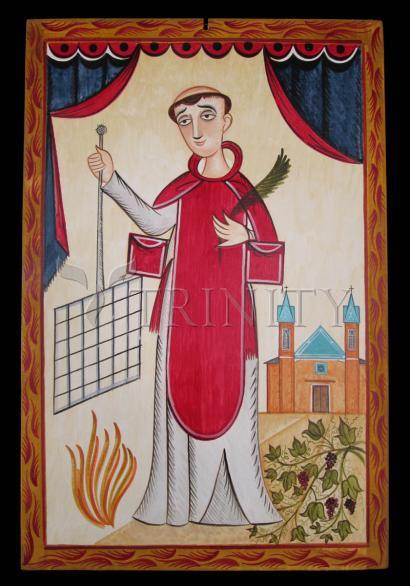Collection: St. Lawrence

-
Sale
Wood Plaque Premium
Regular price From $99.95 USDRegular priceUnit price per$111.06 USDSale price From $99.95 USDSale -
Sale
Wood Plaque
Regular price From $34.95 USDRegular priceUnit price per$38.83 USDSale price From $34.95 USDSale -
Sale
Giclée Print
Regular price From $19.95 USDRegular priceUnit price per$22.17 USDSale price From $19.95 USDSale -
Custom Text Note Card
Regular price From $300.00 USDRegular priceUnit price per$333.33 USDSale price From $300.00 USDSale -
Sale
Wall Frame Espresso
Regular price From $139.95 USDRegular priceUnit price per$155.50 USDSale price From $139.95 USDSale -
Sale
Wall Frame Gold
Regular price From $139.95 USDRegular priceUnit price per$155.50 USDSale price From $139.95 USDSale -
Sale
Wall Frame Black
Regular price From $139.95 USDRegular priceUnit price per$155.50 USDSale price From $139.95 USDSale -
Sale
Canvas Print
Regular price From $84.95 USDRegular priceUnit price per$94.39 USDSale price From $84.95 USDSale -
Sale
Acrylic Print
Regular price From $114.95 USDRegular priceUnit price per$127.72 USDSale price From $114.95 USDSale -
Sale
Metal Print
Regular price From $114.95 USDRegular priceUnit price per$127.72 USDSale price From $114.95 USDSale
ARTIST: Br. Arturo Olivas, OFS
ARTWORK NARRATIVE:
O glorious Saint Lawrence, Martyr and Deacon, who, being subjected to the most bitter torments, did not lose your faith nor your constancy in confessing Jesus Christ, obtain in like manner for us such an active and solid faith, that we shall never be ashamed to be true followers of Jesus Christ, and fervent Christians in word and in deed, even in spite of trials, persecutions, or the sword. Amen.
His feast day is August 10.
- Art Collection:
-
Saints & Angels
- Patronage:
-
Wine Makers,
-
Students,
-
Stained Glass Workers,
-
Schoolchildren,
-
Poor,
-
Laundry Workers,
-
Deacons,
-
Confectioners,
-
Butchers,
-
Armories,
-
Archivists,
-
Brewers,
-
Comedians,
-
Cooks,
-
Fire,
-
Librarians,
-
Restauranteurs,
-
Seminarians
Since the fourth century St. Lawrence has been one of the most honored martyrs of the Roman Church. Constantine the Great was the first to erect a little oratory over his burial-place, which was enlarged and beautified by Pope Pelagius II (579-90). Pope Sixtus III (432-40) built a large basilica with three naves, the apse leaning against the older church, on the summit of the hill where he was buried. In the thirteenth century Honorius III made the two buildings into one, and so the basilica of San Lorenzo remains to this day. Pope St. Damasus (366-84) wrote a panegyric in verse, which was engraved in marble and placed over his tomb. Two contemporaries of the last-named pope, St. Ambrose of Milan and the poet Prudentius, give particular details about St. Lawrence's death. Ambrose relates (De officiis min. xxviii) that when St. Lawrence was asked for the treasures of the Church he brought forward the poor, among whom he had divided the treasure, in place of alms; also that when Pope Sixtus II was led away to his death he comforted Lawrence, who wished to share his martyrdom, by saying that he would follow him in three days. The saintly Bishop of Milan also states that St. Lawrence was burned to death on a gridiron (De offic., xli). In like manner, but with more poetical detail, Prudentius describes the martyrdom of the Roman deacon in his hymn on St. Lawrence ("Peristephanon", Hymnus II).
The meeting between St. Lawrence and Pope Sixtus II, when the latter was being led to execution, related by St. Ambrose, is not compatible with the contemporaneous reports about the persecution of Valerian. The manner of his execution--burning on a red-hot gridiron--also gives rise to grave doubts. The narrations of Ambrose and Prudentius are founded rather on oral tradition than on written accounts. It is quite possible that between the year 258 and the end of the fourth century popular legends may have grown up about this highly venerated Roman deacon, and some of these legends have been preserved by these two authors. We have, in any case, no means of verifying from earlier sources the details derived from St. Ambrose and Prudentius, or of ascertaining to what extent such details are supported by earlier historical tradition. Fuller accounts of the martyrdom of St. Lawrence were composed, probably, early in the sixth century, and in these narratives a number of the martyrs of the Via Tiburtina and of the two Catacombs of St. Cyriaca in agro Verano and St. Hippolytius were connected in a romantic and wholly legendary fashion. The details given in these Acts concerning the martyrdom of St. Lawrence and his activity before his death cannot claim any credibility. However, in spite of this criticism of the later accounts of the martyrdom, there can be no question that St. Lawrence was a real historical personage, nor any doubt as to the martyrdom of that venerated Roman deacon, the place of its occurrence, and the date of his burial. Pope Damasus built a basilica in Rome which he dedicated to St. Lawrence; this is the church now known as that of San Lorenzo in Damaso. The church of San Lorenzo in Lucina, also dedicated to this saint, still exists. The feast day of St. Lawrence is kept on August 10. He is pictured in art with the gridiron on which he is supposed to have been roasted to death.
Born: At Huesca, Spain
Died: August 10, 258; Cooked to death on a gridiron


















